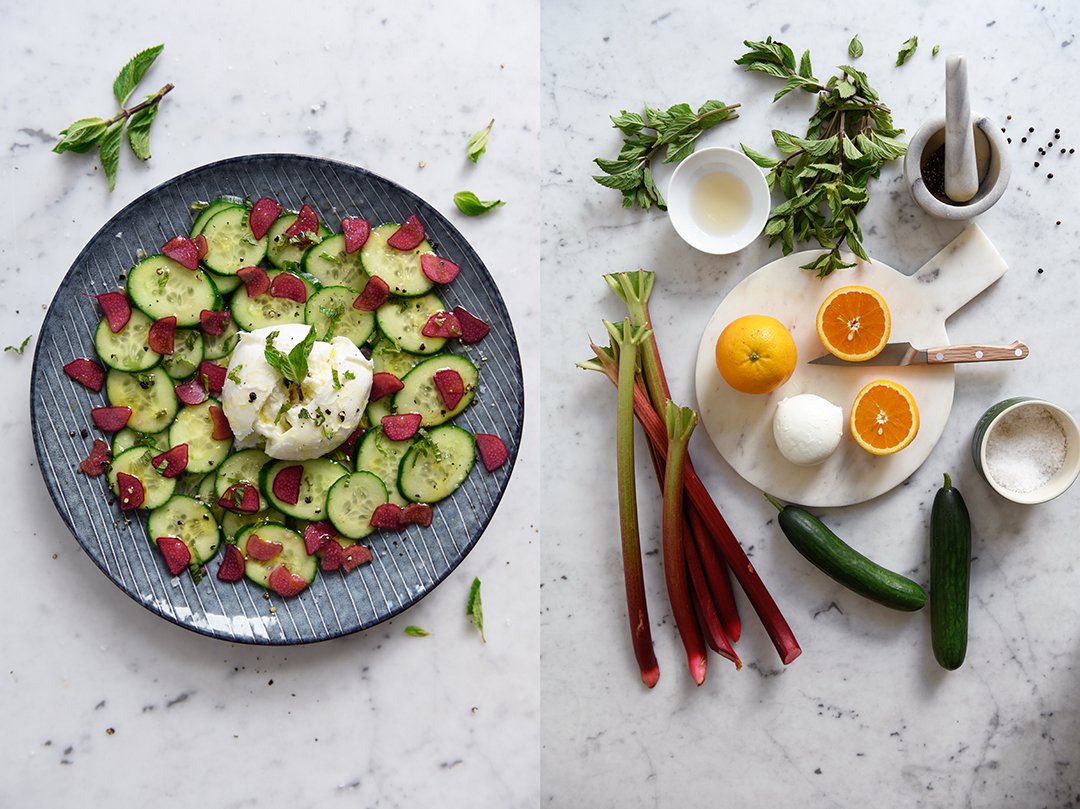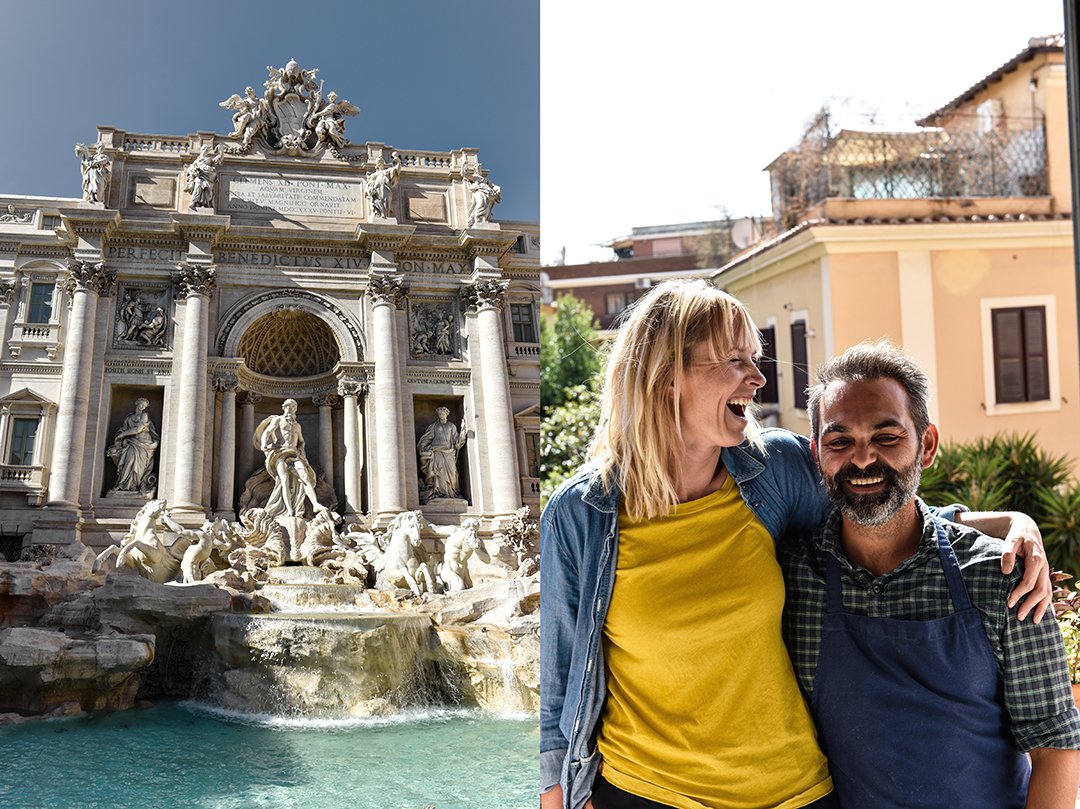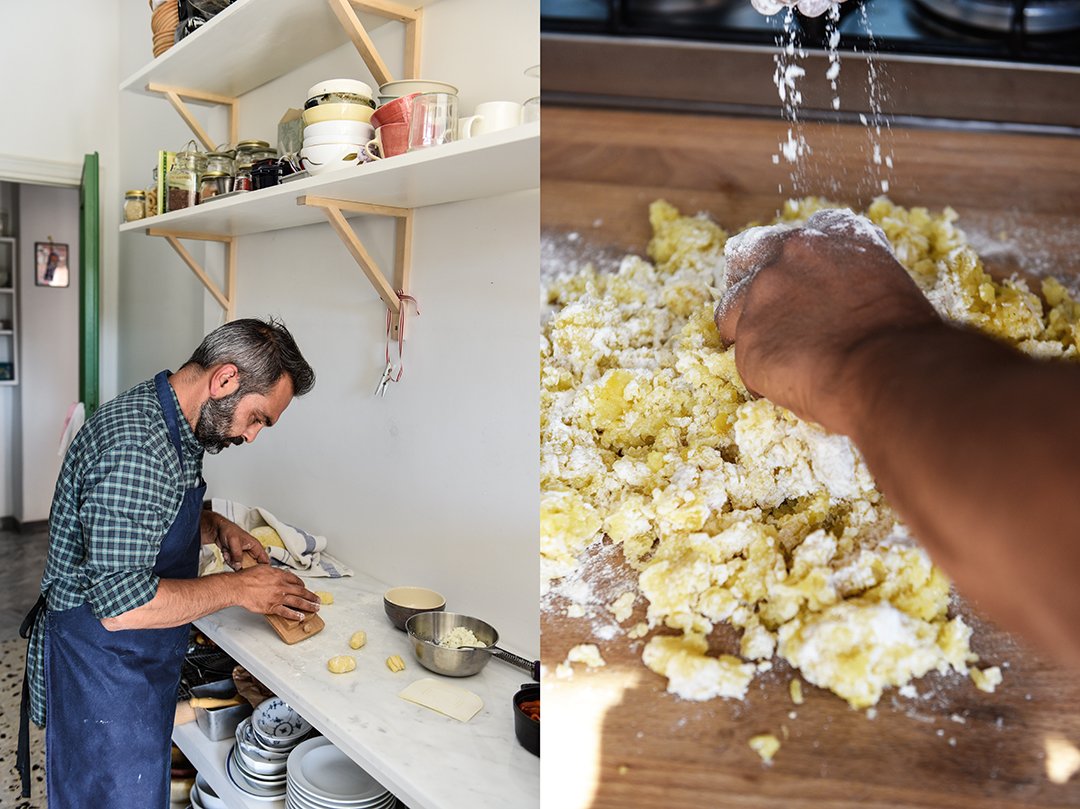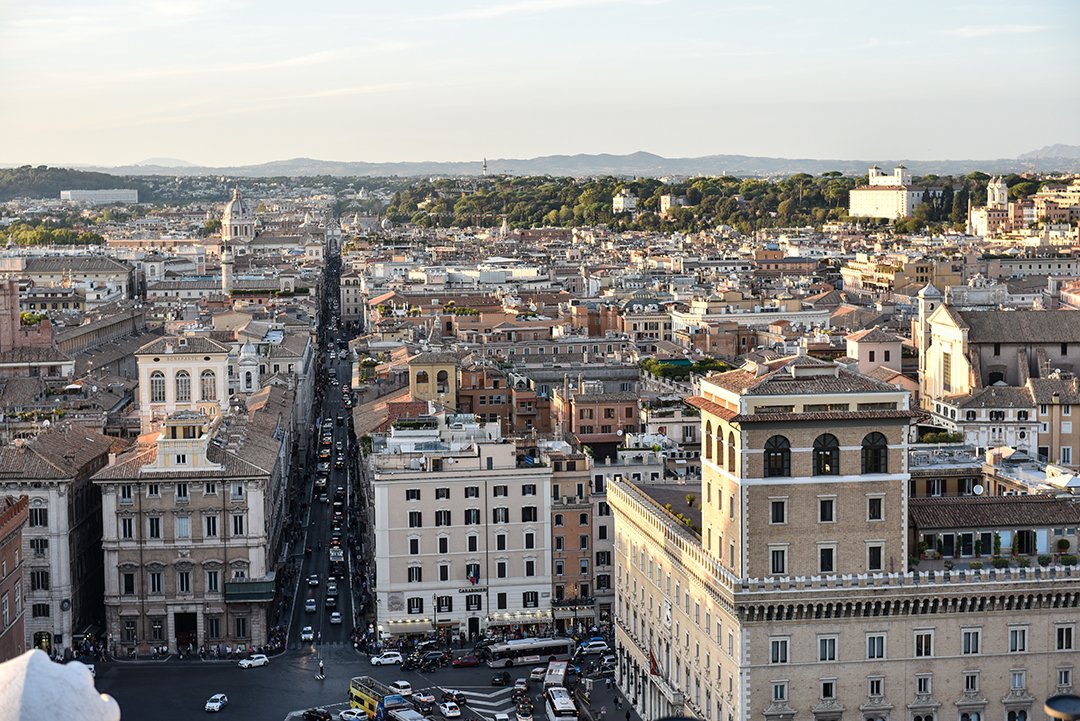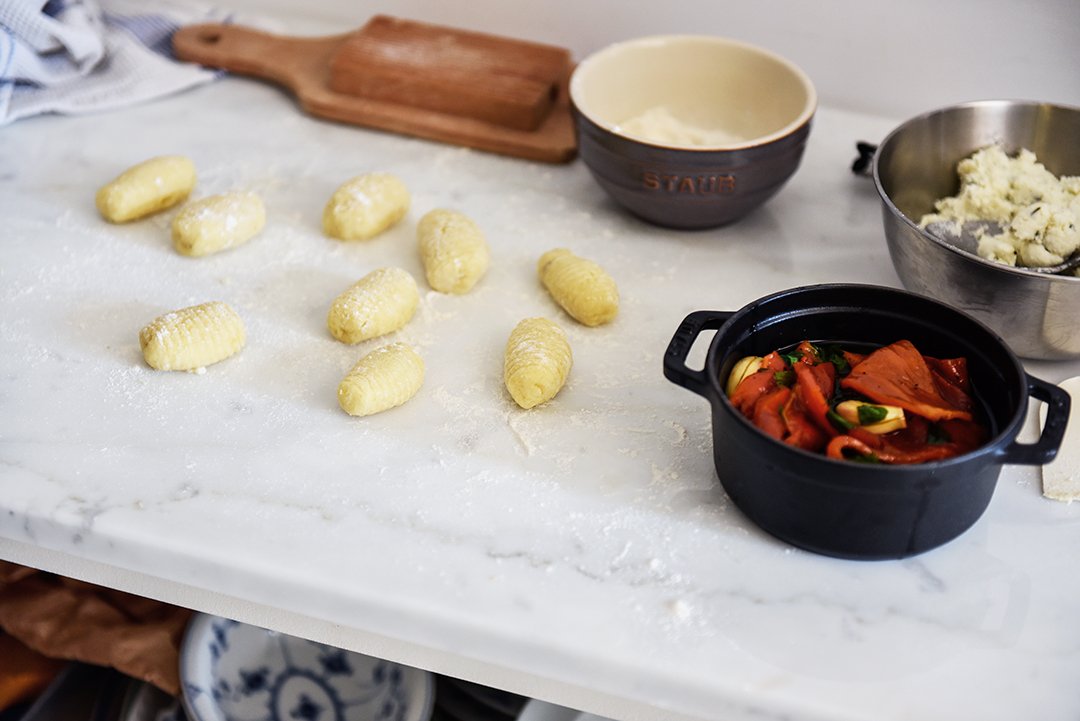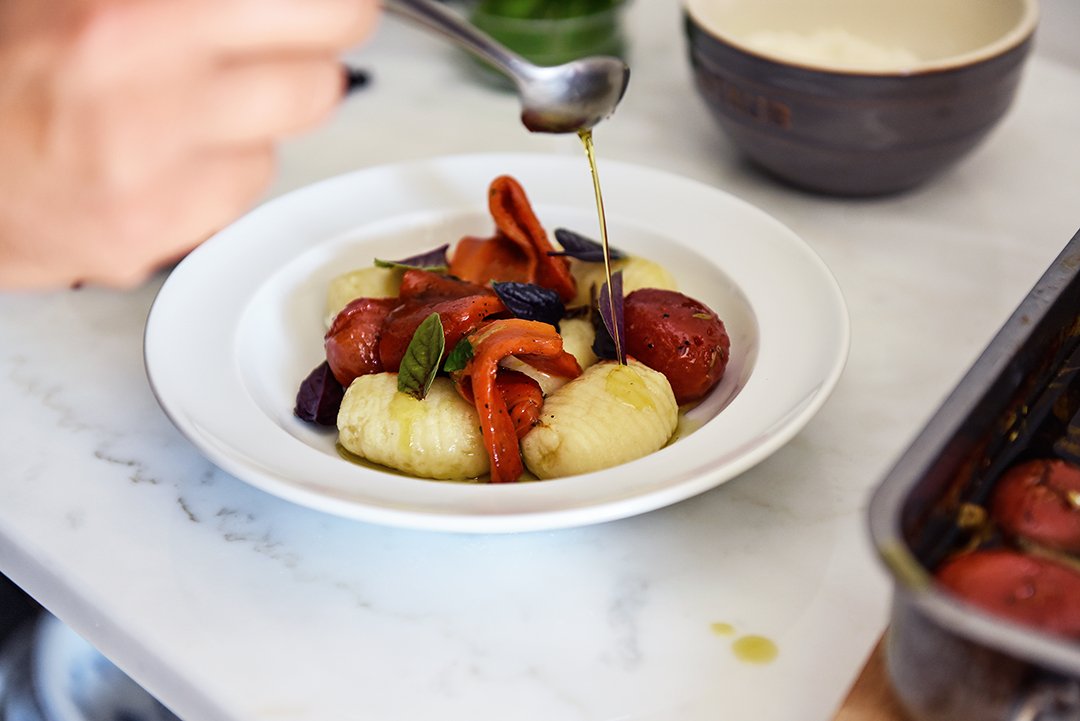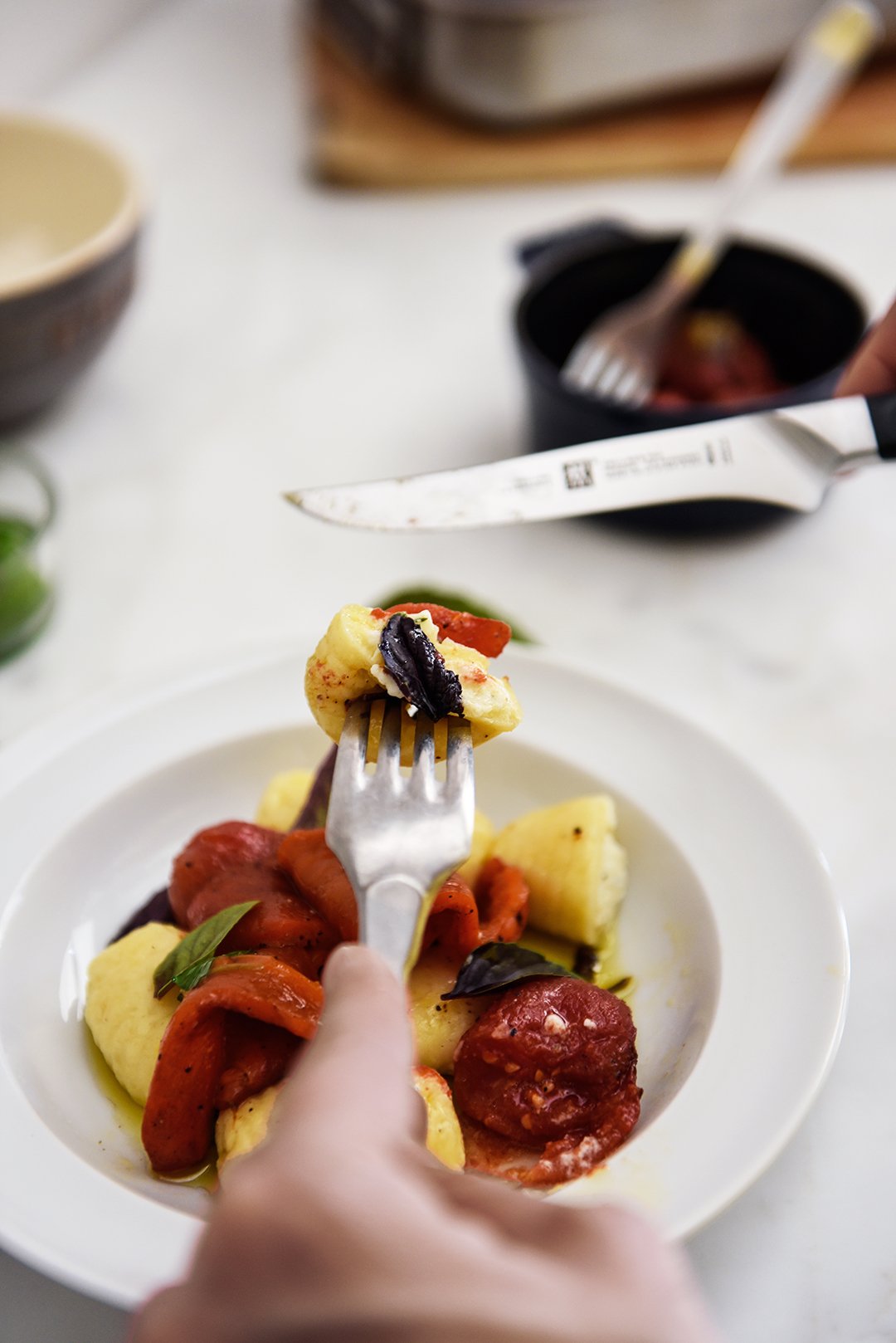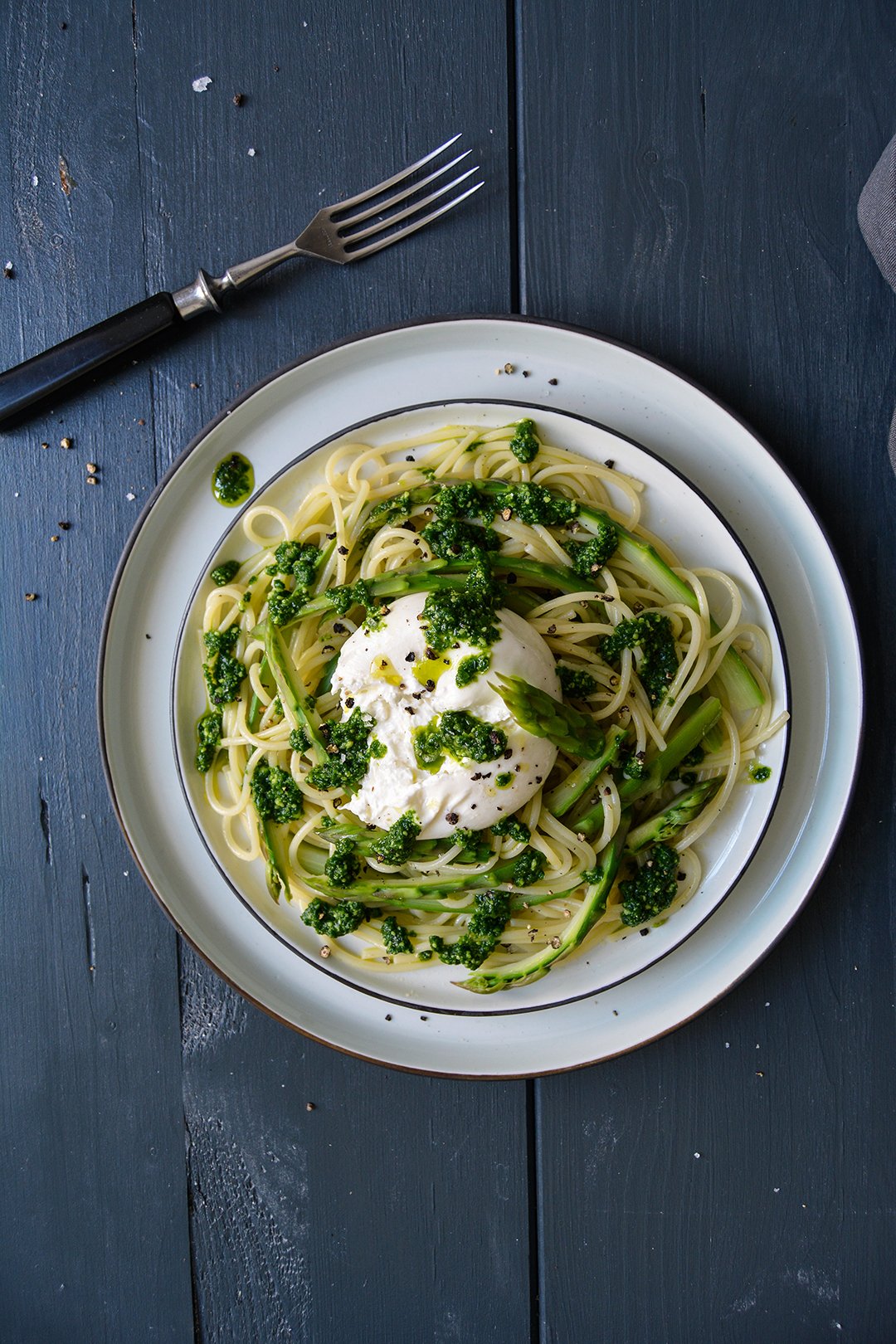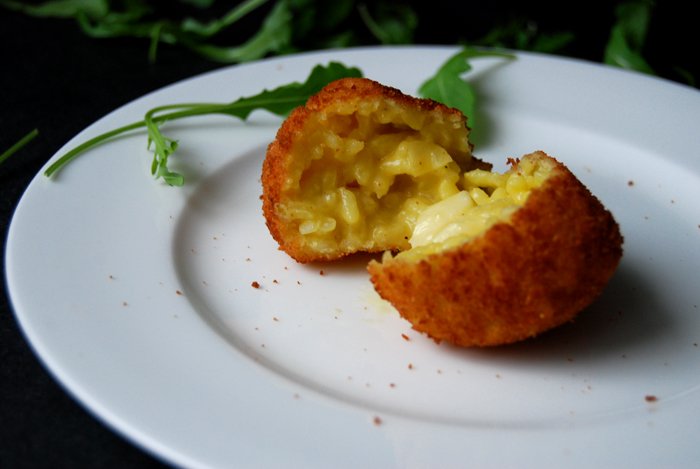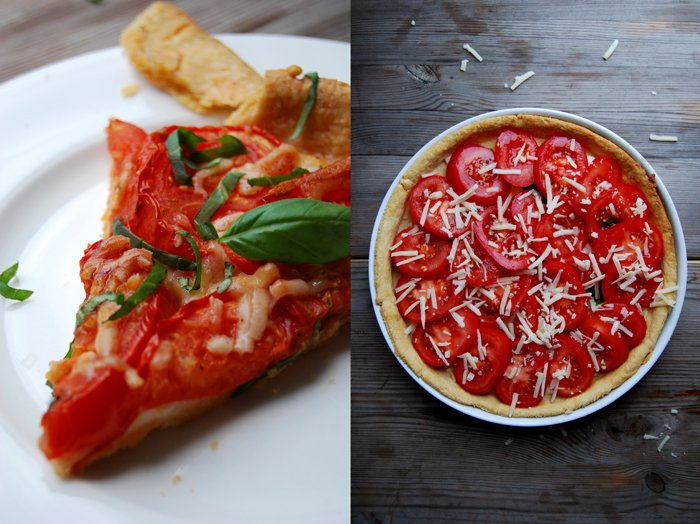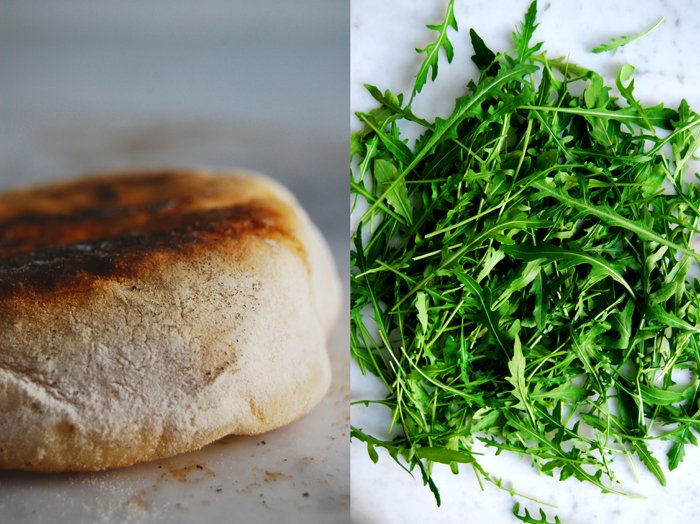Parmigiana di Melanzane
Think of lasagna, replace the pasta sheets with slices of fried eggplant and you have a Parmigiana di Melanzane. It took me many years to finally eat this very frugal, very simple and very delicious Italian home cooking gem and it took me even longer to finally give it a go in my own kitchen.
I have to thank the tiny Sicilian island that I mentioned earlier in May, when I wrote about Stuffed Sardines. This little rock in the Mediterranean rewards me with the best parmigiana for lunch, at a little cafe at the piazza where I sip chilled Chinotto and let my fork sink into silky layers of soft eggplant, creamy cheese and fruity tomato sauce. The island reminds me over and over again how precious good produce is, what a gift tasty vegetables are and how little I have to add as a cook when I allow the vegetables to show their humble inherent qualities.
After writing two cookbooks and sharing hundreds of recipes over the past seven years, I was worried that tiredness might keep me tethered to my minimalist cooking trip but it turns out that the opposite is true. I'm not tired of experimenting, but maybe more than ever I truly and fully appreciate when a tomato, a zucchini or a bell pepper are at their peak and simply taste good. When they taste so good that I don't even want to cook them, my tastebuds have an epiphany. It's not the complex layering in a dish, or the newly discovered combination of flavours that have rarely been combined before, but it is the purest taste of good produce melting in my mouth that makes me the happiest muncher in the world.
On this tiny Sicilian island that I love so much I pick my fruit and vegetables straight from the fields surrounding the house where we live. My early morning walks, to pick what I need for the day before the hot summer sun hits fruit, flowers and leaves, before the plants daily struggle for light, shade and water begins, have taught me more about food in the past few years than any cookbook or food show. Plants follow simple rules, they obey a rhythm. To work - as a cook - with that rhythm and not against it, creates utmost pleasure.
This year, northern Sicily and its surrounding islands didn't have enough rain. Lentils didn't grow, instead their plants dried out on the fields, lemons stayed tiny, the fruits barely having any juice, but on the other side pomodori, tomatoes, grew so abundantly that our friends who have their own fields couldn't keep up collecting and using them. So they gathered one day to make passata, blanched, pureed and strained tomatoes turned into the purest sauce, and bottled their 'red gold' for the colder months to come. If nature gives them tomatoes abundantly, they turn them into a tomato feast. Maybe next year it will be lentils, who knows, but it will definitely reflect in their cooking.
So my friend Pietro gave me a bottle of his deep red passata and although I would have loved to just drink it, I decided to let the sun-kissed concentrated tomato juices shine in a dish that I enjoy so much when I'm in Sicily: I decided to cook my first Parmigiana di Melanzane. This dish is so simple yet there are a million recipes, tricks and variations and every Italian will say that their mamma definitely makes the best. And every one of them is right because there isn't just one recipe that is the best but there is one rule that almost every Italian follows with verve and passion: the ingredients need to be of excellent quality.
You won't need many ingredients for a parmigiana but make sure to use nice, plump eggplants, good fior di latte or mozzarella and Parmesan and most importantly: invest in the best passata you can possibly find. It's also fine to make a tomato sauce from scratch, using tinned or fresh tomatoes and your favoured seasoning, but for this dish, a simple sauce made of Italian passata, garlic, a dash of olive oil, basil, salt and pepper hits the spot. You don't want a sauce that's too dominant as it's only going to play with humble fried eggplants and mainly mild cheese. It's not a sauce I would use for pasta, it's subtle and also more liquid than my usual red sauce, but it bathes the eggplant in the perfect summer-ripe fruitiness. This simple sauce with its deep taste of Mediterranean tomatoes is what makes or breaks your parmigiana.
My recipe is for 4 to 5 people, we enjoyed it over two days, hot, warm and cold, but I wished I had doubled the recipe!
Parmigiana di Melanzane
Serves 4 to 5
1.2 kg / 2 2/3 pounds eggplants, cut lengthwise into 5mm / 0.2" thick slices
Fine or flaky sea salt
3 fior di latte or mozzarella (each 125g / 4.5 ounces)
Olive oil
2 large cloves garlic, crushed
About 750ml / 3 1/4 cups Italian passata di pomodoro(if your passata isn't very tasty, use about 1l / 4 1/4 cups passata, bring it to a boil and reduce until you have the desired amount. Alternatively: Make the same amount of sauce with tinned or fresh tomatoes)
1 large handful fresh basil leaves, roughly chopped
Freshly ground black pepper
Vegetable oil, for frying
60g / 2 ounces Parmesan (preferably aged), finely grated
Spread the eggplant slices on cooling racks, generously sprinkle with salt, gently rubbing the eggplants with the salt, then flip and sprinkle the other side with salt. Let the eggplants sit for about 1 hour then rinse with cold water and pat dry with kitchen paper.
Place the fior di latte (or mozzarella) in a colander, let sit for 1 hour then cut into small cubes.
In a large pot, heat a splash of olive oil over medium heat, add the garlic and cook for about 2 minutes or until golden. Add the passata and bring to a boil. Stir in the basil and season to taste with salt and pepper (mind that the Parmesan will also add saltiness to the final dish!); immediately remove the sauce from the heat and set aside.
Preheat the oven to 200°C / 400°F and grease a roughly 20x30cm / 8x12" baking dish with a little olive oil.
In a large heavy pan, over high heat, heat enough vegetable oil to come up the side of the pan about 1.25cm / 0.5". When the oil is sizzling hot, fry the eggplant slices in batches, arranging them side by side and turning them once, for about 30-60 seconds or until golden but not dark (see picture below). Spread and drain the fried eggplant on kitchen paper and continue frying the remaining eggplant slices.
Arrange a layer of eggplant slices in the prepared baking dish, spreading them side by side, then season with a little (!) salt and pepper, sprinkle with some of the fior di latte and Parmesan and drizzle with some of the sauce. Repeat to make more layers (about 4 layers total), finishing the last layer with cheese and sauce. Bake for about 40 minutes or until bubbly then turn off the oven, tilt or open the oven door and let the parmigiana sit in the oven for 10 minutes or even for 1 hour or longer to let it soak the juices (I let mine sit in the oven for 2 hours, temperature and texture were just right when we ate it). Enjoy the parmigiana warm but not hot straight out of the oven; we even had some cold for breakfast.
Rhubarb and Cucumber Caprese
After months of calming my mind and palate with familiar comfort dishes - creating a soothing counterpart to the uncertainties in the world - I suddenly feel a growing appetite for kitchen experiments again. Pizza, spaghetti Bolognese, German stews and roasts, and yes, baking sourdough bread, gave me comfort and safety while the world turned upside down and pulled me off my feet. But I recently started to feel curious and hungry again, searching and finding a refreshing caprese salad with pickled rhubarb, orange blossom water, cucumber, mozzarella di bufala and mint.
As I leaved through Marc Diacono's fabulous new book, Sour, which was nominated for a James Beard Award this year, I immediately stopped on page 147 as I spotted a vibrant pink Rhubarb and Radish Salad. Marc uses raw rhubarb that he cuts very thinly and marinates in rose water. That made me think. I always cook, bake or roast rhubarb and wasn't quite sure if I'd fall in love with its distinct taste and texture when raw. The British cookbook author adds blue cheese and dill and this, in combination with the rose water, wraps it up snugly. It's sour, it's bold and somehow harmonic, or in Marc's words: "The rose water sets everything off and encourages the radish and rhubarb to sit a little closer together while retaining their independence."
So I asked myself, would that also work with orange blossom water? And what about quickly pickling the rhubarb first and adding crisp cucumber and a hint of fresh mint? I find blue cheese too strong for cucumber but a creamy mozzarella di bufala or Burrata would work. All of a sudden I had a very unusual caprese salad in front of me that had all the crispness, sourness and excitement that I was hoping for. To be fair, one can only truly appreciate this unorthodox caprese variation if one loves sour and is up for having some fun with an Italian classic. I have a Winter Caprese with Blood Orange, Beet and Mozzarella di Bufala in my 365 book and when I came up with that recipe I understood that a) a good mozzarella di bufala and especially Burrata can deal with strong flavors and b) playing with a traditional recipe is a good way to keep tradition alive.
Rhubarb and Cucumber Caprese
Serves 2
1 slim rhubarb stalk (around 60g / 2 ounces), trimmed and thinly sliced with a mandoline slicer or sharp knife
60ml / 1/4 cup white balsamic vinegar
2 teaspoons granulated sugar
60ml / 1/4 cup orange blossom water (or freshly squeezed orange juice)
flaky sea salt
1 small / Persian cucumber (with skin, rinsed), thinly sliced with a mandoline slicer or sharp knife
125g / 4.5 ounces mozzarella di bufala or Burrata
2 tablespoons freshly squeezed orange juice
2-3 tablespoons olive oil
crushed or coarsely ground black peppercorns
4-6 fresh (young) mint leaves, very finely sliced
Transfer the rhubarb to a medium, heat-resistant bowl. In a small saucepan, bring the vinegar, sugar and a pinch of salt to a boil. Stir in the orange blossom water, keep it on the heat just until it starts boiling then pour over the rhubarb and let sit for about 1 hour. You will use the rhubarb and the pickling liquid for the caprese salad.
Quicker but less satisfying: In a small bowl, mix the rhubarb with 2 tablespoons of vinegar, 2 tablespoons of orange blossom water, 1 teaspoon of sugar and a pinch of salt and let sit for 10 minutes. The texture will be tougher and not as crisp compared to the properly pickled rhubarb described above.
Spread the cucumber and 1/3 of the pickled rhubarb on a large plate, adding more rhubarb once you tasted it, and arrange the mozzarella in the middle. In a small bowl, whisk together 2 tablespoons of the pickling liquid and 2 tablespoons of orange juice then drizzle over the salad. Drizzle with the olive oil, sprinkle with a little salt, pepper and mint (mind that the mint is very powerful!). Taste and add more of the pickling liquid if you prefer more of a sour note. Enjoy the salad immediately.
Meet In Your Kitchen | Love, Rome & Gnocchi
Imagine your friends throw an opulent dinner party in the pulsing heart of Rome on a Saturday night und you take over their kitchen hours before the guests arrive with a film team of four to peek over your hosts' shoulders into their pots and pans. Sofie Wochner and Domenico Cortese dealt with our little invasion with remarkable patience. They even welcomed us with big smiles on their faces and a plate full of fresh buttery Danish cinnamon buns in their hands.
The passionate couple is a confident team in the kitchen, they complement each other and combine two worlds that are geographically and culturally far apart, but somehow match smoothly. Sofie is a Danish baker and pastry chef with the impulsive temper of an Italian Signorina, self-taught Chef Domenico comes from Calabria, from the southern tip of Italy, but totally lacks the Mediterranean drama that one would expect. His voice is calm and his movements are concentrated, he's quiet and focused when he works in the kitchen. He says he was born in the wrong country, he feels much closer to the northern European mentality, whereas his woman only feels as free and inspired as she wants to be when she's in her adopted city, in Rome.
A city kitchen is often a space of improvisation and elaborate compromises, the smallest but also the most charming room of an apartment. It's the place where everybody meets at a party, making use of every square inch, squeezed and snuggled in, the happy crowd talks, eats, and drinks until dawn. Our hosts' kitchen is just such a magical place, but it's also a room where the two chefs manage to create the most wonderful dishes for private gatherings, catering, and highly anticipated supper clubs. When it's time to open the doors for their Eatery In Rome pop-up restaurant in their flat's dining room, the kitchen turns into a busy laboratory functioning like clockwork. Loaves of bread and cakes baking in batches in the single oven, pillowy gnocchi rolled and shaped on the wooden board at the window, and bell peppers roasting in the flames of the old gas cooker. The room is bright, facing the pretty balcony, Domenico's beautiful little herb garden where basil, thyme, and rosemary grow happily under Rome's ever shining sun - all waiting to be used in the masters' glorious recipes, like their Stuffed Gnocchi with Mozzarella di Bufala, Confit Tomatoes and Flame-roasted Bell Peppers (you can find the recipe below). The potato gnocchi melt in your mouth like fluffy clouds, the creamy filling makes it smooth and fits perfectly to the candy-like tomatoes and smoky peppers. It's a delicious stunner, a colorful homage to the beauty of Italian cuisine.
In the past few months, the busy duo made their dream come true and started working on their new baby: Marigold. If you would like to support Sofie and Domenico and help them fund their new restaurant and micro bakery in the Roman neighborhood Ostiense, click here.
Many new Meet In Your Kitchen features took me to California, Japan, France, and Italy in the last few months. Thanks to Zwilling for sponsoring these features for our culinary trip around the world!
Mozzarella di Buffala stuffed Gnocchi with Confit Tomatoes and Flame-roasted Bell Pepper
By Domenico Cortese & Sofie Wochner – Marigold, Rome
You can find the German recipe here.Prepare the confit tomatoes and roasted bell pepper a day in advance.Serves 4
Flame-roasted Bell Pepper
1 large red bell pepper
3 cloves of garlic, crushed
1/2 medium bunch of parsley, leaves only, chopped
Fine sea salt
Ground black pepper
About 150ml / 2/3 cup olive oil
You can either grill peppers in the flames of a gas cooker (that's what Domenico does) or grill or roast them in the oven (on the highest temperature, turning them every few minutes until partly black), which is the safer method.
Place the pepper on the gas flame of your cooker set on medium heat. Turn the pepper every now and then, mind that the skin turns dark and forms blisters evenly on all sides. Transfer the hot pepper to a bowl and cover with cling film, let it sit for 15 minutes. Use a small, sharp knife to peel the pepper, cut it in half, and scrape out and discard any seeds and fibers. Cut into strips and transfer to a bowl. Add the garlic, parsley, salt, and pepper and cover with the olive oil. Cover the bowl and let it sit for at least a few hours, or over night.
Confit Tomatoes
8 tomatoes, preferably Piccadilly tomatoes
Fine sea salt
Ground black pepper
3 medium sprigs fresh savory
4 medium sprigs fresh thyme
10 medium sprigs fresh basil
3 cloves of garlic, crushed
Olive oil
Bring a medium pot of water to a boil. Fill a large bowl with ice water.Clean and score the skin of the tomatoes. Blanch them for 20 seconds in the boiling water, then transfer to the ice water. Use a small, sharp knife to gently pull off the skin without cutting them. Transfer to a small baking dish, season with salt and pepper, and cover with cling film. Let them rest in the fridge overnight.
Take the tomatoes out of the fridge about 1 hour before roasting them. Preheat the oven to 130°C / 275°F.
Spread the herbs and garlic on top of the tomatoes and cover them completely with olive oil. Roast for about 4 hours or until they are soft.
Gnocchi
For the filling
150g / 5 ounces mozzarella di buffala
50g / 2 ounces Parmesan
3 sprigs fresh basil, leaves only, plus a handful leaves for serving
1/2 tablespoon olive oil
Fine sea salt
Ground black pepper
For the gnocchi
500g / 18 ounces floury potatoes
1 small egg
50g / 2 ounces Parmesan
Fine sea salt
Ground black pepper
Freshly grated nutmeg
100g / 3/4 cup plus 1 tablespoon flour, type 00
For the filling, purée the mozzarella, Parmesan, basil, olive oil, salt, and pepper in a food processor or blender until smooth. Season to taste with salt and pepper and chill in the fridge for 10 minutes.
For the gnocchi, boil the potatoes in unsalted water for about 30-40 minutes or until soft. Drain and let them rest for 10 minutes. Peel the potatoes and press them through a potato ricer onto a large chopping board or kitchen counter, form a little dome. Add the egg, Parmesan, salt, pepper, and nutmeg and, using your hands and a dough scraper, mix everything together. Add the flour in batches and mix quickly until the gnocchi mixture is combined. Add more flour, if it's too sticky; mind not to over mix it.
Form the gnocchi while the mixture is still warm: Cut off a handful of dough, keep the remaining dough covered with a tea towel, and roll it into a 2.5cm / 1 inch-thick roll. Cut into 1cm / 0.5 inch-thick slices. Using 2 fingers, make a dent in the middle of each slice. Add a tablespoon of the filling and close the gnocchi by rolling it in your hands. Transfer the gnocchi to a baking sheet dusted with flour. When all the gnocchi are filled, cook them immediately in salted water (it should taste like the sea) for about 3-4 minutes or until they raise to the surface; or freeze them, but don't keep them in the fridge.
Using a slotted ladle, transfer the gnocchi to the plates. Arrange the confit tomatoes and roasted peppers on top, drizzle with the oil used to roast the tomatoes, and sprinkle with fresh basil.
Buon Appetito!
Can you tell us a little bit about yourself?
Sofie Yes, I’m Danish and I moved to Rome four years ago to live with Domenico. Straight away, we started our little pop up restaurant in our home here in Rome. I make the bread and the pastry. So we divide the work between the two of us.
And you’re the chef, Domenico?
Domenico Si! Our work is completely separate. I’m not so good with pastry because I don’t like to follow the recipe, but I like the freestyle more.
Sofie You’re a creative soul.
Domenico I'm a chef and I don't know how to work with recipes. I need to be creative and use my inspiration – from my work at the American Academy as well as from my Italian background. Now I have arrived at a place in my life where I have really found my own style.
When did you arrive here in Rome?
Domenico It was in January 2000. Before that, I spent 5 years of my life in Holland and I then decided to come back to Rome - especially because part of my family is here.
Where are you from originally?
Domenico I’m originally from Tropea, a small town in Calabria, where I grew up until I was 18.
Sofie, what made you leave Denmark?
Sofie I’ve always been extremely adventurous and I always felt that maybe Denmark, or maybe Copenhagen, was a little bit too small. That the mentality is – without sounding arrogant – but it’s a bit closed and I’m kind of a loud person (laughing)! So I felt coming to Italy, I kind of came home in a way. Here, there is space to be who you are. You don’t need to fit into a little box. But I still love Denmark and Copenhagen and where I grew up. I go back quite often but I really feel at home in Rome.
Domenico Lucky me!
How do you bring your two worlds together, the Danish and the Italian mentality?
Sofie In many ways I’m more Italian than Domenico is. And he’s more Danish than I am in the sense that Domenico is very precise and he’s always on time. Yes, you’re quite organized and structured.
Domenico Honestly, maybe too much sometimes!
Sofie You’re too Danish sometimes (laughing)! In many ways, I’m very attracted to the southern part of Europe because you’re allowed to express your passion and your feelings in a way that comes very natural to me. I feel welcome and I feel very much at ease here. For us, I think we meet in the middle. Of course, it’s not always easy…
Domenico No, not really!
Sofie …being from two different cultures. A relationship is always hard work but in many ways we also find a way to balance it out by being attracted by each other’s cultures. Domenico could easily live in Denmark if that happened one day but I prefer to live here!
Can you tell us a little bit about your supper clubs?
Sofie Yes, it started 3 1/2 years ago now. It came a little bit by coincidence. We both had this dream about opening a restaurant. And you don’t do that overnight. So we thought maybe we could just start at home. How many tables can we fit into the living room?
Domenico Yes, let’s try and see how it will work. Which kind of guests can we get?
Sofie So it started a bit like that and from the beginning it’s been quite successful. It really gave us the possibility to try out our own style…
Domenico ... to show to our guests what we can do.
Sofie Domenico, you could really try to work on your own style and I think you discovered more and more about who you are through your cooking here than you’ve done anywhere else. And it’s fun! It’s fun to play around with so many things and we are still using the best, seasonal, and local produce. We don’t necessarily cook amitriciana – we try to use the products in a new way, but still keeping the roots in the simplicity of the Italian kitchen…
Domenico …the basis is the Italian cuisine but of course we kind of try to change a little bit or invent something new.
Sofie It’s a feast! In our pop-up restaurant at home we have 12 people sitting at a long table, so you’re eating with people you don’t know but who you get to know very quickly. It’s one big dinner party with people you don’t know which is very unusual here. And every dinner and every evening is completely different to the others, but there’s always a good energy.
Domenico Yes, I can hear it from the kitchen!
Sofie People are chatting away…
Domenico …and laughing! It’s nice!
Did you ever have a funny experience?
Sofie We had a very, very romantic experience! We had two guests, they both came here before, and then one evening, they were here at the same time – they didn’t know each other – and they started to chat over the table. So they met and they got together and then they came back with their parents and they’re in a serious relationship. And they keep coming back! I think they’ve been here like four times! So they kind of grew with us. It was a really cute thing and they are such lovely people.
And then one day they will bring their children!
Sofie Exactly (laughing)!
Do you think that the people who come to Rome, the tourists, have a very clear idea of what they expect to eat when they come to this city?
Sofie Yes. I think it’s fair enough because you come to the most ancient city in the world, so of course it’s not vibrant, modern, things are not changing every half year with a new trend. Of course you know what you’re getting. Unfortunately, because there are so many tourists passing through Rome the quality of even these key dishes in the city is just not good enough. They don’t respect people enough here, and they’re not being proud enough about what they do. I think that’s disturbs us sometimes. Who doesn’t love a creamy cacio e pepe? Or a carbonara? But you don’t need to put cream in there! There shouldn’t be cream in there. They don’t expect that the people coming here to visit can actually taste what they eat. That’s a bit of a shame because Rome also doesn’t have the best reputation. In Paris, there has been this small revolution and I think slowly I can see it happening here too. The younger generations are observing that there is something to be done here, that we’re losing something if we don’t respect our traditions more. Even though the traditions are very strong, it’s not expressed in the actual plate in front of you.
Domenico, what is your greatest kitchen hack?
Domenico For the gnocchi, you need to have really good, starchy potatoes. You can choose between two kinds of potatoes, but the trick to make really good gnocchi is to have starchy potatoes!
What about you, Sofie?
Sofie Being a Dane, I have to mention Danish butter because I actually use Danish butter here. Italian butter doesn’t have the right structure. It’s really important when you do pastry that you use the right kind of butter. It doesn’t necessarily need to be organic either. Often, organic butter tends to hold too much water which means your pastry or your cake can become wet in a way – it doesn’t get the right structure. I can only use French butter or Danish butter in my pastry. So, I believe the basic key is to use really, really good butter. And lots of it (laughing)!
If you could choose one person to cook a meal for you, who and what would it be?
Domenico My mom. I have a lot of memories as a child, but I remember I really liked the minestrone. She used to strain everything but it was so good.
Sofie I’m very, very fond of the way Chad Robertson from Tartine Bakery in San Francisco bakes his bread. I even went there to see them bake. But for him to bake a loaf of bread for me, take it out of the oven and serve it to me with Danish butter (laughing), I think I would be in heaven!
Mille grazie, Sofie and Domenico!
Spaghetti with Asparagus, Burrata and Ramp Pesto
I think spring is my favourite season - until I feel the same in summer, autumn, or winter, depending on my mood. Spring offers a lot of drama and surprises. The changeover from the cold season is so drastic, so abrupt. There's so much energy around and inside me all of a sudden without even knowing where it's coming from. The temperature rises, nature's sprouting and flourishing at every corner, adding colour to a scene that was brown and grey only a few weeks ago. I welcome these changes with gushing excitement and open the doors to my kitchen for all those greens that are soon to come to my cooking space.
In the past couple weeks, the fragile leaves of fragrant ramps brought Mediterranean pesto back to our table. And crisp asparagus is next. The official harvest start of the white asparagus from Beelitz happened last week, so let the feasting begin! When I eat the white stalks, I'm quite a traditionalist. Young potatoes, ham, and Hollandaise sauce is all I need. But when it comes to green asparagus, I become more experimental.
This little lunch was as simple as it was stunning: I added the green stalks, boiled and very thinly sliced, to a plate of warm spaghetti, burrata (mozzarella di Bufala would also work), and ramp pesto. You could also go for a basil or arugula (rucola) pesto, but I enjoyed the subtle oniony flavour in my green creation. In case you disagree, you'll find the links to all three pesto recipes below. Buon Appetito!
Spaghetti with Asparagus, Burrata and Ramp Pesto
Serves 2
For the ramp pesto
(here you can find alternative recipes for basil or arugula pesto)
ramps or ramson, leaves only, 1 medium bunch (around 60g / 2 ounces)
parmesan 30g / 1 ounce
olive oil 60ml / 1/4 cup
salt 1/4 teaspoon
For the pasta
green asparagus, the bottoms cut off, 1 pound
spaghetti 150-200g / 5-7 ounces
olive oil
burrata (or mozzarella di Bufala) 200g / 7 ounces
ramp pesto about 4 tablespoons
flaky sea salt
black peppercorns, crushed with a mortar
For the pesto, purée the ingredients in a blender or food processor until smooth and season with salt to taste.
Cook the asparagus in plenty of salted water for about 3 minutes or until al dente. Using a slotted ladle, transfer the asparagus to a colander (leave the water in the pot), rinse the stalks briefly with cold water, and drain. Using a sharp knife, lengthwise, quarter each stalk into 4 long pieces (including the heads).
To cook the pasta, put the pot you used for the asparagus back on the heat, bring the water to the boil (add more water if necessary), and cook the spaghetti until al dente. Drain, transfer back to the pot, and stir in a tiny splash of olive oil.
Divide the pasta and asparagus between 2 plates, folding the vegetable into the spaghetti. Break the burrata in half and place in the middle of each pasta plate. Drizzle with pesto and a few drops of olive oil (optional) and season with salt and crushed pepper to taste. Serve immediately.
Beluga Lentil Burger with Mozzarella, Pomegranate and Dukkah
My late summer of 2016 feels like an emotional roller coaster. And when there's too much work to be done it's so easy to panic, to be overwhelmed or to just give up. But I believe that we don't give up because there are wonderful people around all of us who catch us when we fall.
Many people catch me at the moment, some must already have sore arms and I can't thank them enough for being there for me and going through this rather intense time together with me. They listen to a crazy woman whose first cookbook will come out soon, in just a few days, and whose ups and downs can be more than tiring. They listen to me, they cook for me, they calm me down, and make me laugh. Many of them have been in my life for years and years, some I've only met a few days, weeks, or months ago. This post is for all these amazing people around me, thank you!
When I needed a spontaneous translation of a press release from English to Maltese a few days ago, I could count on my dear friend Jessica who even worked on it during a camping trip on the weekend. And Nikola, who I never even met before, made it possible to proof read it within a couple hours after I got in touch. My boyfriend is my rock, there wouldn't be this book without him, and Eat In My Kitchen wouldn't be as inspired as it is - my man is the biggest joy one can possibly have in life. The other day I was looking for accommodation in New York and someone who I haven't even met before helped me out without hesitation. And when I was chatting with Hetty McKinnon from Arthur's Street Kitchen about a meet in your kitchen feature this week, I mentioned that I'm planning my book launch event in NY at the moment and that I was struggling. It's a bit tricky when you're on another continent, everything takes much longer. Within a split second, Hetty offered to cook my recipes for my book launch event in Manhattan. I could go on and on, the list of people who've helped and supported me is long and I know it will become longer and longer in the next few weeks.
We're not alone, and that's wonderful, there are times to help others and there are times to receive help from the people around us. We should never forget that we're not alone.
I dedicate this recipe to everyone who has helped me, to my friends, my family, and everybody who I met and will meet on this journey and who makes it even better. It's a recipe that combines different tastes and textures: nutty Beluga lentil burgers and creamy mozzarella di bufala sprinkled with fragrant dukkah spice and nut mixture and juicy pomegranate. It's as vibrant, rich, and colourful as we all are. You can turn it into a sandwich, as I did, but that's not even necessary.
A big hug to all you wonderful people around me! xx
Beluga Lentil Burger with Mozzarella, Pomegranate and Dukkah
Makes 2 sandwiches
For the dukkah
30 g (1 ounce) skin-on hazelnuts
30 g (1 ounce) salted pistachios
30 g (1 ounce) white sesame seeds
30 g (1 ounce) sunflower seeds
1 teaspoon fennel seeds, crushed with a mortar and pestle
1 teaspoon coriander seeds, crushed with a mortar and pestle
1/2 teaspoon black peppercorns, crushed with a mortar and pestle
1/2 teaspoon coarse sea salt
1/4 teaspoon ground cumin
For the lentil burgers
1 bay leaf
2 small sprigs fresh lemon thyme
60 g (2 ounces) beluga lentils (no soaking required)
40 g (1 1/2 ounces) drained canned cannellini beans, rinsed and roughly mashed with a fork
1 spring onion (green part only), thinly sliced
1 small clove garlic, crushed
1 large egg
40 g (1 1/2 ounces) Parmesan, finely grated
20 g (2 tablespoons) dry breadcrumbs
1 teaspoon freshly grated lemon zest
1/2 teaspoon fine sea salt
ground pepper
olive oil, to cook the burgers
For the sandwiches
2 rustic white buns, cut in half
4 lettuce leaves125 g (4 1/2 ounces) mozzarella di bufala, torn into small pieces
olive oil
1/2 pomegranate
1-2 teaspoons freshly grated lemon zest
You won't need all of the dukkah for this recipe. Store leftover dukkah in an airtight container and use it in salads and soups.
For the dukkah, pulse the ingredients in a food processor until crumbly—the mixture should be dry—and transfer to a bowl or an airtight jar.
For the lentil burgers: Fill a large pot with water, the bay leaf, and thyme. Add the beluga lentils and bring to the boil. Cook, according to the package instructions, for about 18-20 minutes. The lentils should have some bite. Remove and discard the herbs, drain the lentils, and let cool completely.
Preheat the oven to 200°C (400°F). Line a baking sheet with parchment paper.
In a large bowl, combine the lentils with the beans, 3/4 of the spring onion, the garlic, egg, Parmesan, breadcrumbs, lemon zest, salt, and pepper. Use your hands or a large spoon to mix until well combined. Wet your hands and form the mixture into 6 burgers.
In a large, heavy pan, heat a generous splash of olive oil over medium-high heat. Turn the heat down to medium and cook the burgers, flipping once, for 2 to 3 minutes per side or until golden brown. Transfer to the lined baking sheet and bake for 8 minutes in the oven.
Divide the lettuce leaves, lentil burgers, and mozzarella among the sandwiches and drizzle with olive oil. Sprinkle with the pomegranate seeds, fresh lemon zest, the remaining spring onion, and some dukkah. Close the sandwiches and enjoy!
Arancine - Sicilian Rice Balls with Saffron and Mozzarella
If you're still looking for a festive vegetarian dish for your Christmas table I can only recommend these little golden balls of rice refined with saffron and stuffed with melted mozzarella, the famous Sicilian arancine! Imagine a bright yellow risotto alla milanese cooked with aromatic saffron in a strong both, mixed with egg yolk and parmesan and shaped into little dumplings. The balls are stuffed with mozzarella and fried with a coating of flour, egg and breadcrumbs until golden brown (which is done in less than a minute). The result looks like tiny oranges which gave them their name arancini or arancine in Sicily, derived from the Italian word for orange, arancia.
Sometimes they are also filled with mushrooms, pistachios or aubergine, or with a meaty tomato sauce, a rich ragù, like in Malta where I love to eat them for lunch at my local confectionary, Busy Bee. The old fashioned atmosphere of the marble panelled cafe on the Msida seafront is my favourite place for a little midday snack and an espresso when we're on the Mediterranean island. The room is often filled with the same business people and elderly couples and I imagine them meeting at this café for a date like they have done all their life. We all enjoy the authentic cooking and traditional Maltese and Italian dishes which taste like mama's kitchen.
I went for a simple filling with mozzarella as I wanted to enjoy my arancine on a light and fruity salad of orange, fennel and rucola. The mild cheese merges perfectly with the risotto's saffron aroma and the whole composition makes quite a pretty platter!
Arancine with Mozzarella
The oil is very hot, so you should always fry with lots of care!
For 4 people (about 15 small arancine) you need
Arborio rice 200g / 7 ounces
medium onion, finely chopped, 1
vegetable or meat broth around 600ml / 2.5 cups (depending on the rice you will need more or less liquid)
white wine 100ml / 1/2 cup
a pinch of saffron
salt and black pepper
olive oil
organic egg yolks 2 plus 2-3 eggs to coat the arancine
Parmesan, freshly grated, 20g / 3/4 ounce
mozzarella, cut into small cubes, 80g / 3 ounces
plain flour, a large handful, to coat the arancine
breadcrumbs, a large handful, to coat the arancine
vegetable oil for deep-frying, around 1l / 2 pints (plus more depending on the size of the pot you use)
fennel bulb, very thinly sliced, 2
orange, peeled and cut into filets, 2
rucola (arugula), a big handful
Mix the wine and saffron.
In a large pot, heat a splash of olive oil and sauté the onions on medium heat for about 2-3 minutes until soft. Stir in the rice and cook on medium heat for 1 minute. Add the saffron wine and some of the broth, the rice should be covered, stir and turn the heat down to medium-low. When the liquid has been absorbed add more broth, a little at a time, stirring in between. Depending on the rice, it will need more or less liquid. When the rice is al dente and the broth is absorbed take it off the heat and season with salt and pepper to taste. Close with a lid and let the risotto sit for a minute. Stir in the egg yolks and Parmesan and let the mixture cool completely.
Heat the vegetable oil in a large pot. Check if it’s hot enough with a wooden toothpick, little bubbles should form around the toothpick.
Prepare three deep plates, spread flour on the first one, beat the eggs on the second one and fill the last one with breadcrumbs.
Prepare a little bowl with water, wet your fingers and take a heaped tablespoon of the risotto. Form a small, thick disc in your wet hand palm, put 2-3 mozzarella cubes in the middle of the rice and form a round dumpling. The cheese should be completely covered. Gently roll the dumpling like a snow ball in the flour, then in the eggs (this has to be done quickly so that it doesn't fall apart) and finally, roll it in the breadcrumbs. Continue with the remaining risotto and put the arancine on a large plate or baking sheet (they will flatten a bit, you have to put them back into a round shape before you fry them in the oil).
Fry the arancine for about 1 minute in the hot oil, turning them in between. They should be golden brown but not dark. Take them out with a slotted ladle and put them on kitchen paper to remove excess oil.
Divide the fennel, orange and rucola between the plates and drizzle a little olive oil over it. Serve the warm arancine on top of the salad.
Orecchiette with Roasted Cherry Tomatoes, Buffalo Mozzarella and Basil
This meal started off with an image in my head. Quite often I imagine recipes visually, I can see the colours, the texture, the whole composition is just waiting to get out of my head onto a plate. For days I've been mentally carrying a Tuscan picture with me (it's Tuscan to me at least). I had a big bowl of orecchiette in mind, topped with roasted cherry tomatoes on a branch. I could see the woody sprig turning black and the firm skin of the red fruit grilled and burst creating a smoky sweetness to mix with my pasta. Sprinkled with pieces of Buffalo mozzarella and fresh basil it turns into a tasty beauty in green, white and red - the Italian flag on a plate!
This is another one of these simple and perfect Italian dishes, the classic combination of tomato, mozzarella and fresh herbs which I love so much in various recipes. It is as good as an insalata caprese which I mix with mint as it is in a Panzanella, a Tuscan salad made with stale bread, a recipe which is on the top of my cooking list for when I'm in Malta (which will be very soon!). You can throw it on pizza, quiche or mix it with any kinds of pasta, warm or cold, with rosemary, oregano, thyme or whatever your herb garden offers. This is the essence of pure Italian comfort food!
Orecchiette with Roasted Cherry Tomatoes, Mozzarella and Basil
For 2 people you need
orecchiette 200g / 7 ounces
cherry tomatoes on a branch 500g / 1 pound
Buffalo mozzarella, torn into bite sized pieces, 125g / 4.5 ounces
big basil leaves, torn, 10
olive oil 50ml / 1 3/4 ounces
garlic, cut in half, 1 clove
salt and crushed black pepper
Cook the pasta in lots of salted water al dente.
Turn on the grill of your oven, put the tomatoes (on their branches) on a baking dish and roast for 12 minutes or until their skin starts to turn black and burst.
In a saucepan, warm up the olive oil together with the garlic and leave on a medium-low heat for 1-2 minutes.
Divide the pasta between 2 big plates, mix with the garlic olive oil and top with mozzarella, basil and a roasted branch of tomatoes. Sprinkle with salt and crushed pepper.
Tomato and Buffalo Mozzarella Quiche
7 months and 210 recipes ago I started eat in my kitchen, it was last November when this adventure began and I had no idea what to expect. I just knew that I wanted to write a post about our food every day, to share my recipes and my love for cooking and baking and that's what I've done till today and what I will continue in the future. When I saw the amount of recipes gathered on the blog, I realized how much has happened since that grey day in November. So much that my webpage can't even keep up with it, the Recipe page seems to have reached its capacity limit (which I'm working on fixing at the moment!). For now you might not find all the older recipes in the recipe index.
It's been an overwhelming time, I have received so many emails, so much support and interest in my culinary activities. I want to thank you for that, it's an amazing experience and a wonderful chance to meet food lovers all over the world who want to join me in my kitchen! I'm very happy about every single comment I get from you, every email and photo I receive about my recipes that you've cooked or baked in your kitchen!
I've been asked quite often if my cooking has changed in the past few months through the blog. Not really, I've always loved creating delicious food with my pots and pans, quite excessively to be honest, but luckily we have many friends who help out whenever I miscalculate how much 2 people can eat! It doesn't matter how many cakes I bake there are always enough hungry people around me!
There's no better way to celebrate than with one of my favourite recipes, my beloved quiche! It made its first appearance with leek and tomato, followed by a fennel tart and my bean and ramp quiche. Today's tart is a delicious tomato, Buffalo mozzarella and basil quiche, the pastry buttery and crisp (as always) but with a little change, I added some olive oil to the dough. The topping is a celebration of Italian summer flavours, sweet tomatoes, creamy Buffalo mozzarella and fresh green basil leaves. It reminds me a bit of pizza, just more fine and buttery!
Tomato and Buffalo Mozzarella Quiche
For one quiche you need a round (27cm / 10.5″) or oval baking dish or tart pan.
For the short crust base
flour 250g / 8.5 ounces (I use white spelt flour type 630 but you can use any other plain flour)
butter, cold 125g / 4.5 ounces
olive oil 1 tablespoon plus more for brushing the pastry
organic egg 1
salt 1 teaspoon
Combine the flour with the salt. Cut the butter with a knife into the flour until there are just little pieces of butter left. Continue with your fingers and work the butter into the flour until combined (there shouldn’t be any lumps of butter left). Add the egg and olive oil and continue mixing with the hooks of your mixer until you have a crumbly mixture. Form a disc, wrap in cling film and put in the freezer for 15 minutes.
The topping
medium tomatoes, sliced, 4
Buffalo mozzarella, drained and very thinly sliced, 125g / 4.5 ounces
Parmesan, grated 30g / 1 ounce
fresh basil leaves 14 plus 8 leaves (chopped) for topping when the quiche is done
salt and pepper
The quiche
Set the oven to 210°C / 410°F top/ bottom heat.
Roll out the dough between cling film and line your baking dish with the flat pastry. Prick it with a fork and blind-bake in the hot oven for 10 minutes. Take it out of the oven and set the temperature down to 180°C / 355°F.
Brush the pastry with a thin layer of olive oil, spread the mozzarella and basil on top and cover with the tomatoes. Sprinkle with the parmesan, season with salt and pepper and bake for about 25 minutes or until the tomatoes are soft. Let it cool for 10 minutes and sprinkle with the fresh basil.
Buffalo Mozzarella, Cuore Di Bue Tomato and Mint Salad
When I saw these beautiful Cuore Di Bue Tomatoes in the vegetable department of my local organic shop I had to buy them. I know these tomatoes from Malta where farmers sell them from their vegetable trucks at every street corner in the towns. These mobile shops are piled high with ripe, colourful fruits and vegetables from the island, surrounded by women chatting and exchanging the latest gossip while waiting to have their vegetables weighed. Many of them have been going to the same farmer for years and I gladly follow this tradition. Whenever I'm there I buy my groceries from my vegetable man, Leli, twice a week he parks his truck under pink oleander trees in the middle of Msida. He is one of the most friendly, calm and humble people I know, he doesn't talk much but he always has a little smile on his face. Before we leave the island at the end of our holidays, we visit him one last time to say good-bye, I never know who is more sad, him or us!
Back to the Cuore Di Bue Tomatoes, I buy and eat them in bulk when I'm Malta. Their taste is far away from most of the tomatoes you can buy in the cities, they are strong and sweet, very intense, they taste like real tomatoes! Their name comes from their shape and size which is similar to an ox heart but I thought that the Italian name, Cuore Di Bue sounds a bit nicer than Oxheart Tomatoes!
I had a buffalo mozzarella in my fridge which had to be used soon, a quick salad mixed with my beautiful tomatoes was the first idea that came into my mind. I still love this Italian classic which can be a delicious starter or snack when it's made with good quality ingredients. Unfortunately, lots of restaurants offer it made with tasteless tomatoes and mozzarella, which has damaged its image a little over the years. Buffalo milk however creates a very strong mozzarella which is great for this salad, to add a green taste as strong as this cheese, I replaced the traditionally used basil with mint. Our salad for 2 was ready within seconds, 125g / 4.5 ounces of buffalo mozzarella roughly torn into bite sized pieces mixed with 2 ripe Cuore Di Bue tomatoes sliced thinly and a few leaves from my mint plant. The dressing was as easy, 3 tablespoons of olive oil whisked with 2 tablespoons of Balsamico vinegar, salt and pepper.
Serrano, Mozzarella di Bufala and Pesto Focaccia
When my brother in law stayed with us 2 weeks ago I asked him about his favourite sandwich. I often ask friends as it's a great inspiration for my Sandwich Wednesday but it's also interesting to find out about different sandwich preferences. It may sound silly, but a favourite sandwich says a lot about a person! He answered quick and with a smile on his face, Serrano prosciutto, mozzarella and pesto sandwich with toasted pine nuts on top. He is a true gourmet, I know and appreciate his sense for fine food, so I didn't wait too long to get all the ingredients, I was curious!
I chose an Italian Focaccia bun from my bakery for this sandwich, juicy and baked with lots of olive oil and sprinkled with sea salt. I bought 8 thin slices of Serrano and one Mozzarella di Bufala of 125g / 4.5 ounces which I cut into thick slices. I made a quick pesto, a handful of basil leaves chopped finely with a big knife, mixed with a tablespoon of good olive oil and some salt. While I cut the 2 buns open and filled them with the prosciutto and mozzarella, I toasted the pine nuts in a sauce pan without oil on medium heat for a couple minutes until golden. I drizzled the pesto and pine nuts on top, took the first bite and smiled like my brother in law did when he told me about this absolutely delicious sandwich! It's great!
If you would like to share your favourite sandwich with me, just get in touch! I would love to try different sandwiches from all over the world, quick ones, complicated ones, exotic, puristic or sumptuous, whatever your taste buds like! Just get in touch here,
Meike xx
Umbrian Torta al Testo with Rucola and Mozzarella
This week's sandwich is my version of Torta al Testo - the Umbrian flatbread - stuffed with rucola and mozzarella together with a dressing of olive oil and balsamico. Originally, this bread is unleavened, just made with flour, salt and water. I add some dry yeast, some use baking soda or sourdough. The name Torta al Testo comes from the fact that, traditionally, it is cooked on a hot disc of clay or metal - al testo - over the open fire, as I don't have that I use a skillet on a normal cooker.
Torta al Testo has everything a good sandwich needs: amazing bread and a tasty filling. What I also like about it, is the way it's cooked. It's fun to see the flat disc of dough rising and cooking in the hot pan within a couple minutes. It's very entertaining! I recently had friends over for dinner and Torta al Testo was the starter. We gathered in the kitchen, crowded as always, I cooked the bread and we all watched it rise. The kitchen was packed with people and food, I cooked one batch of flatbread after the other (I had to make quite a few of them) and the room got more and more smokey from the hot pan. Thankfully no one left, even though you could barely see anymore after I had left one in too long. We were all kind of mesmerized by the rising bread but don't worry, if you watch your bread it will be fine, no need for a fire alarm!
Torta al Testo with Rucola and Mozzarella
For 6 Torta al Testo you need
For the dough
plain flour 250g / 9 ounces plus more for mixing (I use spelt flour type 630 but you can use any other flour)
dry yeast 1 1/2 teaspoons
water, lukewarm, 140ml
salt 1/4 teaspoon
For the filling
mozzarella, cut into cubes, 125g / 4.5 ounces
rucola around 100g / 3.5 ounces
olive oil (6 tablespoons) mixed with balsamic vinegar (3 tablespoons) and seasoned with salt and pepper
Mix all the ingredients for the dough with the hooks of your mixer. Add some more flour if the mixture is too sticky. After 5 minutes continue mixing with your hands for a couple minutes. Put the dough back into the bowl, cover it with a tea towel and let it rise in a warm place or the warm oven (35°C / 95°F, top/ bottom heat, no fan) for 40 minutes.
Divide the dough into 6 pieces. On a well floured working surface, roll each one out into a flat disc. Leave the discs on the floured surface, cover with a tea towel and let them rise for another 20 minutes.
Heat a large skillet on highest temperature (no oil!). Cook the bread on one side for 1 - 1 1/2 minutes, turn and cook on the other side for another minute, at that point it will start to rise rapidly. You might have to cook it for a few seconds more or less - but keep an eye on it so as not to burn it.
Take the bread out of the pan and let it cool for a minute. Cut your flatbread in half and fill with the mozzarella and rucola. Drizzle some dressing on top and close your Torta al Testo.
My Sunday Pizza Tradition
Another tradition of mine - I always bake pizza on Sundays, always. My friends joke about my unwavering dedication (I barely break this tradition) but to me pizza is the ultimate cosy mood food. Nothing beats an evening on my sofa with a nice big piece of pizza in my hands and a good movie. It's the perfect preparation for a smooth transition into a new week. So why change it. The only variation is what's on top which depends on the season, my appetite and spontaneous inspiration. So far, my Sunday tradition has never seemed boring.
For today, my pizza gets a topping with aubergine slices (grilled with garlic and oregano oil), Pecorino slices and one part with ricotta. A very concentrated tomato sauce with lots of oregano and slices of organic Mozzarella go with it, that's all it needs. I make the pizza dough with olive oil which makes it richer and very tasty. A very easy recipe, it takes its time to rise but it's worth it. Nothing beats homemade pizza dough! It makes such a big difference to the taste - and kneading the dough with your own hands is great stress relief!
For years I made my pizza base the same way. First I let it rise in a bowl and then, a second time, on a baking sheet before I put the topping on. This summer I got a great tip from a friend of mine from Switzerland. He told me to put the baking sheet for the pizza on the bottom of the oven while the oven is heating up. As soon as the baking sheet is hot you take it out of the oven and flip it over. You take the well risen pizza dough (which has been rolled out) and place it on the hot baking sheet. The dough will start to rise and bake straight away which makes an amazing crust - like pizza stone. Once the topping is on, bake it in the oven for a few minutes and you will get the crispiest pizza you can imagine!
Pizza with Aubergine and Pecorino
I start to prepare the dough 2 hours before I bake it to give it enough time to rise.
For 1 big pizza (size of 1 baking sheet) you need
For the dough
plain flour 350g / 12.5 ounces plus more for mixing
dry yeast 1 package (for 500g / 1 pound of flour)
water, lukewarm, 190ml
olive oil 3 tablespoons
salt 1 teaspoon
Combine the flour with the yeast and salt, add the olive oil and the lukewarm water, slowly, not all at once (you might not need all of it). Mix with your dough hooks for a few minutes. The dough shouldn't be moist and sticky at all, more on the dry side. Continue kneading and punching with your hands until you have an elastic dough ball, not too hard, not sticky. Put the dough back in the bowl, cover it with a tea towel and let it rise in the warm oven (35°C / 95°F) for 40 minutes. This works really well but make sure that your oven is set to top/ bottom heat and not to fan.
When the dough is well risen, roll it out on a very well floured (this is very important!) working surface. It should be a bit smaller than the size of your baking sheet. Cover with a tea towel and let it rise for another 10-15 minutes
For the tomato sauce
tinned tomatoes 400g / 14 ounces
oregano, dried or fresh, 1 tablespoon plus more for the topping
salt (1 teaspoon) and pepper
Mix the ingredients in a small sauce pan, chop the tomatoes and let everything cook down until very concentrated and thick. If you leave the sauce too liquid it will be soaked up by your pizza base.
For the topping
I prepared the grilled aubergine (eggplant) a day before. You can keep it in the fridge for days and use it for other recipes as well, or enjoy it as antipasti.
aubergine, cut in thick slices, 1
garlic, crushed, 1 clove
olive oil, to brush the aubergine and to drizzle on top of the pizza
salt and pepper
pecorino cheese, cut in thin slices, 100g / 3.5 ounces
mozzarella, cut in cubes, 125g / 4.5 ounces
ricotta, 100g / 3.5 ounces (I sprinkled just 1/4 of the pizza with ricotta)
Brush the aubergine slices with olive oil, sprinkle with oregano and garlic and season with salt and pepper. Grill in the oven until golden brown and soft and cut in long strips.
The pizza
Set your oven to 260°C / 500°F. My oven has a special pizza setting but you can use top / bottom heat as well. Put the baking sheet on the bottom of your oven to heat it.
Take the hot baking sheet out of the oven, flip it over and place it carefully on two stable wooden boards or mats as it will be very hot. Place your risen dough carefully but quickly (best done by two people) on the baking sheet, push it gently into place if necessary. Spread the tomato sauce on top and sprinkle with oregano, continue with the aubergine, Pecorino, mozzarella and ricotta. Put the baking sheet back into the oven, on the bottom again, and bake for a few minutes until the pizza is golden brown, bubbling and crisp!






